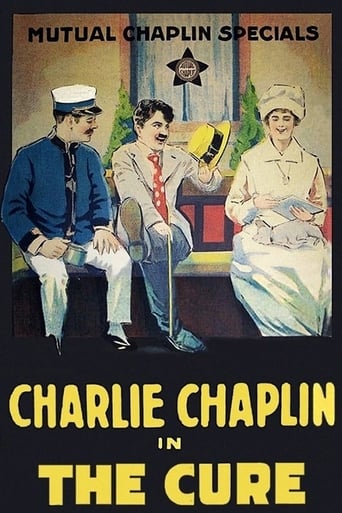Petri Pelkonen
The Cure from 1917 is a Charles Chaplin film in which he doesn't play The Tramp character.He plays an alcoholic who enters a health spa with a big suitcase full of alcohol.There he meets a beautiful girl (Edna Purviance), who could help him become sober.At some point, all of the spa's inhabitants are loaded after the liquor ends up at the health waters.I have never been drunk in my entire life, and intend never to be, but it can be funny to watch comedians portraying drunkards on films.And Chaplin sure plays a funny drunk.And the absence of The Little Tramp isn't a problem, he was in that costume in many other movies.But how funny the movie is, that's the main issue here.And this movie is pretty funny.
Horst in Translation ([email protected])
Charlie Chaplin's 24-minute short "The Cure", written directed and produced by the master himself as always, takes him playing an alcoholic to a health spa this time. It has his usual companions Eric Campbell, very bearded and wearing a cylinder, and Edna Purviance. Early on, we get some mindless revolving door fun, which gets a bit repetitive quickly and afterward inside the spa, as always all kinds of hilarious complications ensue, especially for Campbell's character, when Chaplin displays his usual devastating routine. He turns away Campbell's chair the the moment he wants to sit on it, so the colossus lands on his his giant butt. He jokingly kicks Campbell's plastered leg and many more. I don't think it's as funny as Chaplin's best, but if you're a fan of his, you'll probably like it. Also, besides Chaplin's comedic efforts, it includes a nice message for audiences almost 100 years ago about how devastating alcohol can be to the extent that it can possibly destroy your life and doesn't make you exactly attractive to women (Purviance here) either.
CitizenCaine
Chaplin heads to a spa, which was all the rage back in the day, in the tenth film he edited, wrote, produced, and directed for the Mutual Film Corporation. Although perceptions of alcoholism have changed significantly since Chaplin's time, the rising tide of the temperance movement was influential in passing the eighteenth amendment a couple years after this film was released. Alcoholism was perceived as more a battle of will power than environment or genetics. In The Cure, Chaplin descends on a health spa catering to the hoity-toity and creates chaos as usual. Instead of the tramp, we get Chaplin playing a regular character this time. Chaplin's character, like probably many real life people who went to these spas, has no intention of actually drying out. There are many moments of slapstick, sight gags, and poking fun at the high and mighty. Eric Campbell is on hand as a rich masher with gout. Edna Purviance plays the girl Chaplin helps of course. Henry Bergman plays the bathhouse masseuse as, what Chaplin's character perceives to be, a wrestler. This sequence builds laughs upon laughs and is uproarious, as Chaplin attempts to extricate himself from what he fears to be a very intimidating situation. Revolving doors also play a role in some terrific sight gags. Like many Chaplin films, the film starts slow and picks up as it goes along, an enjoyable departure from the tramp. *** of 4 stars.
didi-5
Much of the delights in this short film involve a tipsy Charlie (whose luggage consists entirely of bottles, to the good fortune of the weirdly bearded porter) and a grouchy, gouty, Eric Campbell - a perfect foil for Chaplin, he'd be much missed after his death in a road accident later in 1917.Edna Purviance, Charlie's usual sweetie in these short films, is a welcome presence, but it is Chaplin himself who shines throughout 'The Cure', whether struggling from the over zealous attention of a Turkish bath attendant, walking his funny walk up steps, or getting stuck along with Campbell in a set of revolving doors.It doesn't get much better than this.
